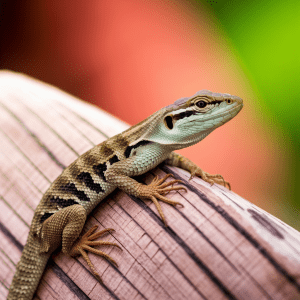Hello there, folks! Picture this: enjoying a sunny day, surrounded by glorious nature, all while discovering the wonder of lizard species unique to Europe. Sounds fantastic, right? Now, what if we told you there are a handful of special areas commonly referred to as "Lizard Diversity Hotspots in Europe?" Here's the catch — learning about these wild gems and what sets each one apart can feel like attempting to decipher a complex maze of science. We've all been there, trust us.
Fear not, because our adventure compass is about to guide you through an enchanting journey worth every bit of your time. We'll embark on a virtual tour, spotlighting Europe's most stunning regions, brimming with lizard diversity. We'll delve into the Mediterranean’s lizard-rich locales, peel back the layers around the reptilian wonders of the Iberian Peninsula, unravel the richness scattered across Central Europe and top it off by exploring Eastern Europe's unique lizard species.
All that's left to say is buckle up, because we are bound to have a heap of fun turning a rather complex subject into a fact-filled but light-hearted guide that compares and contrasts lizard havens across Europe. By the end of this, you'll feel amazed, informed and perhaps, even ready to pack your bags for a real-life lizard expedition! Now, are you ready for this fascinating exploration? Let's dive right in!
Understanding Lizard Diversity Hotspots in Europe
Continuing our exploration into the virtually hidden world of European lizard diversity hotspots, ever wondered how two contrasting destinations offer such varied experiences? Let's journey along to unearth the beauty of not one but two fascinating hotspots: The Western Canary Islands and North Montenegro. Imagine guiding your family through the volcanic terrains of Tenerife and Hierro, pointing out the vibrant colors of the Gallotia species to your curious kids. Compare this to the stark but equally breathtaking beauty of North Montenegro's limestone landscapes, home to different lizard types such as Algyroides nigropunctatus.
Although both regions brim with lizard diversity, each provides a distinct backdrop – the volcanic verses mountainous ecosystem triggering a captivating contrast. Further, while the Western Canary Islands offer relatively easy access and comes packed with family-friendly amenities, North Montenegro appeals for its raw, unspoiled beauty. Picture preparing a traditional picnic for your kids in the heart of a wild nature park. Each hotspot, therefore, brings its unique charm and thrill!
Building on these intriguing contrasts, our journey takes a compelling turn into the very heart of lizard diversity in Europe. However, let's not forget our goal to demystify these microcosms. Stay tuned as we dive deeper into the lizard species you are likely to encounter and how to transform this special-interest adventure into a memorable family holiday. Remember, windswept volcanic plains or rugged mountain peaks? The choice is intriguingly yours!
Exploring the Mediterranean Region
Moving forward in our comparison, let's “explore the Mediterranean region's treasure trove of lizard diversity hotspots in Europe. The petite islands in Greece and the sun-soaked coastlines of Spain don't just score high on aesthetics, they're bonafide lizard utopias as well. Ever wondered how family vacations could mean marvelling at the humble reptiles at close quarters?
To cite an instance, Greece's rocky islands wedged in deep blue waters are home to endemic lizard species. Here, families relish lazy afternoons beachcombing, interspersed with delightful discoveries of vivid-colored lizards cavorting amid the native flora.
Contrastingly, Spain with its biodiversity hot crossroads is synonymous with the exotic painted lil' skink (a member of lizard family). Kiddo freaks out over creepy crawlies? Not to worry! These flashy species exhibiting fascinating synergy with their flamboyant environment can really perk up your little ones' enthusiasm.
Meanwhile, Italy's soulful soggy marshes, largely unscathed by human interference, teem with unique lizard variations. Imagine savouring a serene gondola ride with your excited kids, while curious lizards dart by, adding a dash of adventure.
So, while Greece proffers unique lizard breeding games, Spain invites its visitors into a dynamic drama of exotic lizard life. Conversely, Italy offers a quieter retreat and a candid glimpse into the vulnerable life-cycles of its resident reptiles. Recollecting what we have uncovered, these spots are not just stunning getaways but vibrant classrooms; teaching families to appreciate, respect and understand the value of biodiversity. Who knew, right? Picking your vacation spot was never this exciting!
Uncovering the Lizard Riches of the Iberian Peninsula
Unfolding the lizard wonders of the Iberian Peninsula, we take our imagination to the Mediterranean's sun-drenched landscapes. Ever thought that a family trip to Europe could turn into a mini wildlife safari? Sure, Africa does come to mind when we utter the word "safari". However, Europe, particularly the Iberian Peninsula, paints an equally captivating canvas albeit punctuated with the dots of amusing lizard sightings.
This region has more lizard species than anywhere else in Europe, becoming a haven for herpetology enthusiasts or just about any family seeking to strengthen their hands-on understanding about diversity in life forms. Particularly, the Peninsula teems with startling species diversity, from the humble Ocellated Lizard to the rarer Spiny-footed Lizards.
Navigating this diverse lizard landscape presents family travelers an actual opportunity to see evolution tinkering away. Yet, spotting these scaly creatures isn't as complicated as naming dinosaurs, bingo! It adds an exciting new dimension to a regular family holiday. Imagine your child playing Sherlock Holmes, sharpening their observation skills and learning straight from Mother Nature's hotspots of lizard diversity in Europe.
In contrast, Northern Europe's colder and often severe climate hinders such rich lizard diversity. It becomes evident that amid similarities in policy and infrastructure, the climatic and biodiversity contrasts between these regions are stark and undeniable. It presents a fascinating facet of the European sojourn largely untapped by the average traveler. On one hand, we've uncorked the unparalleled lizard treasures of the Iberian Peninsula; on the other, we've dealt with a contrasting reality of Northern Europe. No fancy skills needed, just an open eye and an open heart to adventure Europe's scaly wonders!
Delving into the Diverse Habitats of Central Europe
Moving forward in our comparison, have you ever daydreamed about taking a lovely family stroll and spotting lively lizards darting around in a sun-dappled forest? Picture this: you're not even paying a ticket for a zoo, but hiking through the vibrant habitats of Central Europe, home to some fantastic lizard diversity hotspots in Europe.
Central Europe, specifically around Hungary and Slovakia, is a treasure trove teeming with lizard life. Unlike the rocky landscapes of Southern Europe, Central European habitats show a stark contrast. Forested areas abundant with the tiny, elusive, but utterly adorable Sand Lizard and enchanting European Green Lizard provide an unmatched adventure for the whole family.
Not only do the landscapes differ, but the reptiles here also display awe-striking multiple color variations- sleek brown, emerald green and even a resplendent mix of bright blues. Aren't these unique biological souvenirs that outshine any physical ones you could purchase?
However, bear in mind the delicate balance these ecosystems hold is crucial to lizard survival. Experiencing and understanding these spots goes beyond sightseeing. It’s educating our future generations about respecting nature's equilibrium.
As we discover these diverse lizard trails, don't you feel a thrilling sense of being an explorer kindled, whatever your age might be? Now pair that invigorating sense of discovery and understanding with the exquisite beauty of Mother Nature, symbolized by lizards in their natural habitats. Nowania that's one of the most tantalizing vacation spots that secures our planet's future!
Discovering the Unique Lizard Species of Eastern Europe
Ever been dumbstruck by the sheer variety of lizards basking on your European getaway? Then brace yourself! Eastern Europe, regaled for its rich culture and heritage, is also a spectacle of an entirely different kind: being one of the top “Lizard Diversity Hotspots in Europe”.
The Balkan Green Lizard, native to this region, stands out with its brilliant green scales. Just imagine: a young, nature-curious mind gaping in wonder at these fantastic, iridescent creatures sunning on the rocks. However, don't limit capturing captivating clicks to one species; this diversity hotspot boasts far more than meets the eye.
Continuing our comparison, though, the sand lizards of Western Europe do make a striking contrast. While they may lack the flamboyant hues of their Eastern counterparts, what the Western lizards lack in color, they definitely make up for in adaptability. Reptile fans, adjust your lenses – sand lizards can change colors according to their environment, a sort of lizard camouflage, if you like.
Bringing up the rear, there's trusty lizards like the Wall Lizard of Southern Europe. Smaller and no less engaging, this little fellow is typically found creeping in mortar cracks and garden nooks. It's a wonderful surprise to stumble upon when you’re least expecting it. What a treat for your eager little explorers, huh?
Comparing these various options clarifies the unique draw of Eastern Europe's lizard diversity hotspot. From brilliantly green Balkan lizards to plucky little wall residents, discovering each species holds a magic all its own. Ah, the omnipresent allure of Europe – tradition, culture, history, and a thrilling abundance of lizards!
Comparing Key Features and Benefits

Continuing our examination, it's clear that there are key benefits to visiting different lizard diversity hotspots in Europe. You might find yourself gravitating toward the warmer climates of southern Greece, the birthplace of Aristotle and Euromed supplements for your child’s biology project. However, have you ever thought about the cooler and damp-humid tones of the Celtic countries, a breeding ground for fascinating celtic-Britain lizards? We get the mystery, but here's the catch.
Southern Greece's wealth in lizard species is unparalleled, thanks to its Mediterranean climate, diverse habitats, and untouched islands. Walking down ancient Greek ruins, imagine your kids spotting a snouted skink scurrying across the path. Now there's a spark for curiosity and a perfect science lesson!
On the other hand, Celtic countries, despite their cooler climes, boast varieties of lizards like viviparous that not only survive but thrive in cold, moist environments. Picture your family in a lush, rolling green landscape of Ireland, spotting these hardy lizards everywhere. It's the same lizard hunt with a different backdrop.
There's no hard or fast rule here. Both locations serve up unparalleled experiences and offer marine reptilian spice to your European voyage. It all boils down to what matters to you most: climate, habitat, or unique lizard species? Not to forget that unforgettable family selfie, either with the historical Acropolis backdrop or emerald-green Irish highlands. What say you? Luxury sunny holidays or cold snuggle nights? Both with their fair share of slithering friends.
And there we have it, folks – an exhilarating journey through some of the most breathtaking lizard diversity hotspots in Europe. From the Mediterranean shores brimming with herptiles, to the exotic baths of the Iberian Peninsula, lizard love is one thrilling adventure away. Perhaps, you've also discovered a newfound fascination for the diverse habitats of Central Europe or marveled at the distinct lizard species lurking within Eastern Europe's nooks and crannies? We've not just seen these diversity hotspots, but experienced the extraordinary thrill they offer, all from the comfort of your armchair.
It's fascinating how these hotspots are each a universe filled with its own little scaled astronauts, isn't it? And now that you've had this grand tour, you might find that one region particularly resonates with you and your family's adventurous spirit. Whichever hotspot tickles your explorer side, you're now armed with the knowledge to make a choice that aligns with your family's interests.
So, what are you waiting for? It's time to pack those bags with sunscreen, hats, safari outfits – and a dollop of curiosity! Round up the kids, hatch a plan, and embark on an incredible venture to meet these scaly friends. Remember, each day teems with possibilities, especially if you know where to look. Start your fine-tuned lizard quest today – there's a whole world of adventures waiting! You've got this!
FAQ:
Question: What makes the Mediterranean region a lizard diversity hotspot in Europe?
The Mediterranean region is characterized by robust biogeographic dynamics resulting from continuous periods of geographic isolation and convergence. Consequently, this interaction has led to a unique richness of endemic lizard species. Moreover, the region's diverse habitats, varied microclimates, and diverse vegetative flora contribute to species diversification and impressive lizard diversity.
Question: Why does the Iberian Peninsula stand out in lizard diversity?
The Iberian Peninsula is renowned for its impressive diversity of lizard species, primarily due to its geographic location and variety of ecospheres. Here, Atlantic, Mediterranean, and mountainous influences converge, indicating a mosaic of habitats that support diverse forms of life. For reptiles, specifically lizards, these conditions allow for an increased range of ecological niches, boosting lizard diversity.
Question: How does central Europe contribute to lizard diversity despite less favorable climate?
Despite its cooler climate, Central Europe proves significant in enhancing lizard diversity. Ecological factors such as varied altitude ranges, numerous river systems, and the Western Carpathians add to its biodiversity. In particular, these factors contribute to an abundance of lizard species adapted to colder habitats, as many species have evolved with remarkable resilience to cooler conditions.
Question: What unique lizard species can we find in Eastern Europe?
Eastern Europe is rich in distinct lizard species. For instance, the Sand Lizard (Lacerta Agilis), is found across a broad region reaching as far as western Asia. Other unique species include the European Green Lizard (Lacerta Viridis) and the magnificent and rare Orsini’s Viper (Vipera Ursinii).
Question: Why is comparing key features and benefits of different lizard hotspots useful?
Comparing key features and benefits across various lizard hotspots is useful for understanding the shaping of biodiversity in different geographical contexts. It also helps in planning conservation measures. Understanding diversity patterns provides vital information on factors supporting lizard biodiversity, informing conservation efforts regarding climate changes, habitat preservation, and possible issues resulting from anthropogenic disturbances. This comparison, therefore, plays an instrumental role in lizard preservation and biodiversity education.



